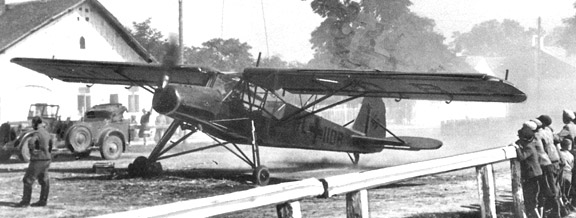LUFTWAFFE RESOURCE CENTER > TRANSPORT/UTILITY > PREVIOUS PAGE


|
Type: STOL multi-role Origin: Gerhard Fiesler Werke Gmbh Production: Almost entirely by Morane-Saulnier, Puteaux and Benes-Mraz, Czechoclovakia Models:A, C, D, E, & Fi 256 First Flight: May 1936 Service Delivery: About May 1937 Final Delivery: 1949, to France POWERPLANT(s): Typical Model: Argus As 10C Type: Inverted V8, aircooled Number: One Horsepower: 240 hp Propeller Unit: Schwartz two-blade fixed pitch wooden propeller FUEL/FLUIDS: Fuel Capacity: 32.56 Imperial Gallons (148 Liters) Lubricant Capacity: 2.42 Imperial Gallons (11 Liters) DIMENSIONS: Wing span: 14.25m (46 ft. 9in.) Wing Surface Area: N/A Length: 9.90m (32 ft. 5¾ in.) Height: 3.00m (9 ft. 10 in.) Stabilizer Span: N/A |
WEIGHTS: Empty: 930kg (2,050 lbs.) Loaded: 1,320kg (2,910 lbs.) PERFORMANCE: Maximum Speed: 109mph (175 kph) Minimum Speed: 32mph (51 kph) Take-Off distance: 65m (213 ft.) Landing Distance: 20m (61 ft.) Range (Maximum Fuel): 966km (600 miles) at 97kph (60 mph) Range (Maximum Payload): 380km (236 miles) Initial Climb: N/A Service Ceiling: N/A ARMAMENTS: One 7.92mm MG 15 mounted in the upper rear of the cabin Ammunition: Three 50-rnd Magazines |
Development: - Source: Wikipedia
In 1935, the RLM (Reichsluftfahrtministerium — “Reich Aviation Ministry”) put out a tender for a new liaison aircraft for the Luftwaffe to several companies. Fieseler's entry was the most advanced in terms of STOL performance, by far. A fixed slat ran along the entire leading edge of the long wings, while the trailing edge, inspired by earlier 1930s Junkers aircraft wing control surface designs, including the ailerons, was a hinged and slotted flap. The wings could be folded back along the fuselage, allowing it to be carried on a trailer or even towed slowly behind a vehicle. The long legs of the landing gear contained oil and spring shock absorbers that compressed about 450 mm (18 inches) on landing, allowing the plane to set down almost anywhere. In flight they hung down, giving the aircraft the appearance of a very long-legged, big-winged bird. Hence its nickname, the Storch. With its very low landing speed the Storch often landed "at place" or even backwards, in case of wind from directly ahead.
Operational Record: - Source: Wikipedia
The Storch could be found on every front throughout the war. It will probably always be most famous for its role in the rescue of deposed Italian dictator Benito Mussolini from a boulder-strewn mountaintop, surrounded by Italian troops. German commando Otto Skorzeny dropped with 90 paratroopers onto the peak and quickly captured it, but the problem remained of how to get back off. A Focke Achgelis Fa 223 helicopter was sent, but it broke down en route. Instead, pilot Walter Gerlach flew in a Storch, landed in 30 m (100 ft), took aboard Mussolini and Skorzeny, and took off again in under 80 m (250 ft), even though the plane was overloaded. The involved Storch rescuing Mussolini bore the radio code letters "SJ + LL" in motion picture coverage of the daring rescue. On 26 April 1945 a Storch was one of the last planes to land on the improvised airstrip in the Tiergarten near the Brandenburg Gate during the Battle of Berlin and the death throes of the Third Reich. It was flown by the test pilot Hanna Reitsch, who flew her lover Field Marshall Robert Ritter von Greim from Munich to Berlin to answer a summons from Hitler. Once in Berlin von Greim was informed that he was to take over command of the Luftwaffe from Hermann Goering. A Storch was the victim of the last dog fight on the Western Front and another was fittingly downed by a direct Allied counterpart of the Storch - a Piper L-4 Grasshopper-from the L-4's crew directing their pistol fire at it. The involved Storch was the only aircraft known to have been downed by handgun fire in the entire war. A total of about 2,900 Fi 156s, mostly Cs, were produced from 1937 to 1945. When the main Fieseler plant switched to building Bf 109s in 1943, Storch production was shifted to the Mráz factory in Czechoslovakia. A large number were also built at the captured Morane-Saulnier factory in France, starting in April 1942, as the MS.500 Criquet. Both factories continued to produce the planes after the war for local civilian markets (in Czechoslovakia it was made as K-65 C(áp, 138 were made by 1949). During the war at least 60 Storchs were captured by the Allies, one becoming the personal aircraft of Field Marshal Montgomery.
LUFTWAFFE RESOURCE CENTER > TRANSPORT/UTILITY > PREVIOUS PAGE
